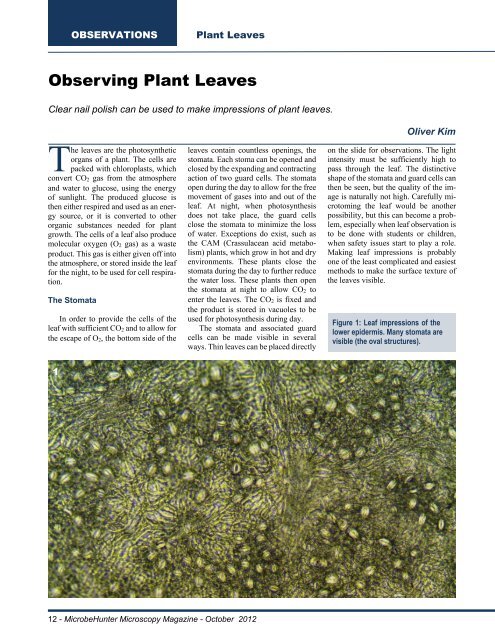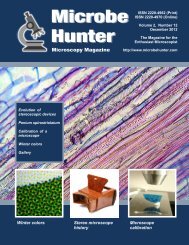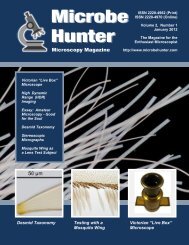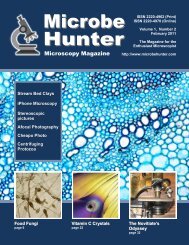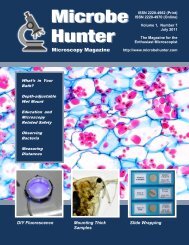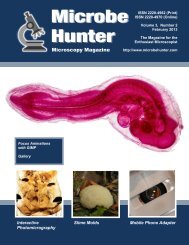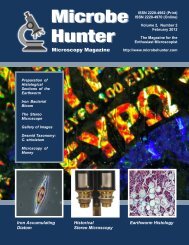October 2012 - MicrobeHunter.com
October 2012 - MicrobeHunter.com
October 2012 - MicrobeHunter.com
Create successful ePaper yourself
Turn your PDF publications into a flip-book with our unique Google optimized e-Paper software.
OBSERVATIONS<br />
Plant Leaves<br />
Observing Plant Leaves<br />
Clear nail polish can be used to make impressions of plant leaves.<br />
The leaves are the photosynthetic<br />
organs of a plant. The cells are<br />
packed with chloroplasts, which<br />
convert CO 2 gas from the atmosphere<br />
and water to glucose, using the energy<br />
of sunlight. The produced glucose is<br />
then either respired and used as an energy<br />
source, or it is converted to other<br />
organic substances needed for plant<br />
growth. The cells of a leaf also produce<br />
molecular oxygen (O 2 gas) as a waste<br />
product. This gas is either given off into<br />
the atmosphere, or stored inside the leaf<br />
for the night, to be used for cell respiration.<br />
The Stomata<br />
In order to provide the cells of the<br />
leaf with sufficient CO 2 and to allow for<br />
the escape of O 2, the bottom side of the<br />
leaves contain countless openings, the<br />
stomata. Each stoma can be opened and<br />
closed by the expanding and contracting<br />
action of two guard cells. The stomata<br />
open during the day to allow for the free<br />
movement of gases into and out of the<br />
leaf. At night, when photosynthesis<br />
does not take place, the guard cells<br />
close the stomata to minimize the loss<br />
of water. Exceptions do exist, such as<br />
the CAM (Crassulacean acid metabolism)<br />
plants, which grow in hot and dry<br />
environments. These plants close the<br />
stomata during the day to further reduce<br />
the water loss. These plants then open<br />
the stomata at night to allow CO 2 to<br />
enter the leaves. The CO 2 is fixed and<br />
the product is stored in vacuoles to be<br />
used for photosynthesis during day.<br />
The stomata and associated guard<br />
cells can be made visible in several<br />
ways. Thin leaves can be placed directly<br />
Oliver Kim<br />
on the slide for observations. The light<br />
intensity must be sufficiently high to<br />
pass through the leaf. The distinctive<br />
shape of the stomata and guard cells can<br />
then be seen, but the quality of the image<br />
is naturally not high. Carefully microtoming<br />
the leaf would be another<br />
possibility, but this can be<strong>com</strong>e a problem,<br />
especially when leaf observation is<br />
to be done with students or children,<br />
when safety issues start to play a role.<br />
Making leaf impressions is probably<br />
one of the least <strong>com</strong>plicated and easiest<br />
methods to make the surface texture of<br />
the leaves visible.<br />
Figure 1: Leaf impressions of the<br />
lower epidermis. Many stomata are<br />
visible (the oval structures).<br />
1<br />
12 - <strong>MicrobeHunter</strong> Microscopy Magazine - <strong>October</strong> <strong>2012</strong>


